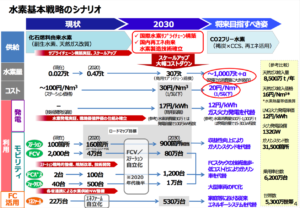Ammonia Positioned for Key Role in Japan’s New Hydrogen Strategy
By Stephen H. Crolius on January 11, 2018
The Japanese government has approved an updated hydrogen strategy which appears to give ammonia the inside track in the race against liquid hydrogen (LH2) and liquid organic hydride (LOH) energy carrier systems. The announcement was made on December 26, 2017, by the Agency of Natural Resources and Energy (ANRE), the lead agency on energy policy within the Ministry of Energy, Trade, and Industry (METI).
In its press release, ANRE said that in the spring of 2017 Prime Minister Shinzo Abe called for the formulation of a plan by year-end for timely realization of a “hydrogen society.” “Receiving the instructions, the related ministries and agencies compiled the strategic plan after discussions at the Hydrogen and Fuel Cell Strategy Council consisting of experts from industry, academia and government.” The Hydrogen Basic Strategy was formally adopted at a Ministerial Conference on Renewable Energy and Hydrogen convened for this purpose.
The Strategy flows out of Japan’s Fourth Strategic Energy Plan (summarized briefly here) and is presented as the fulfillment of the country’s 3E+S framework. The original 3E framework, consisting of energy security, economic efficiency, and environmental conservation, has been in place since at least the early 2000s. Safety was added as a key element in the aftermath of the Tohoku earthquake in 2011.
The Strategy notes that Japan currently meets 94% of its domestic energy needs via imports from other countries. It also cites the national goal of an 80% reduction in greenhouse gas emissions by 2050. These considerations lead to an emphasis on the creation of an “international hydrogen supply chain” involving “utilization of overseas under-utilized and renewable energy” — and a concomitant focus on an energy carrier system that can support the Strategy’s ultimate cost target of ¥20 ($0.18) per NM3 of hydrogen. (A cubic normal meter of hydrogen has approximately the same energy value as a third of a liter of petrol.)
The focus on cost is key because various clues within the Strategy and elsewhere suggest that ammonia started the energy carriers race as the dark horse. Now, however, the discussion of ammonia within the Strategy starts as follows:
Ammonia (NH3) can be
- used to form infrastructure at a lower cost because volumetric hydrogen density is larger (1.5 times that of liquefied hydrogen) compared to other hydrogen carriers,
- manufactured from natural gas relatively inexpensively,
- transported in an existing commercial supply chain.
Also, it can be directly used for power generation etc. without extracting (dehydrogenating) hydrogen from ammonia, and does not discharge CO2 at the time of combustion.
Ministry of Energy, Trade, and Industry: Hydrogen Basic Strategy, 12/26/2017
The LH2 and LOH sections within the Strategy document each start with lists of pros and cons and make no mention of their comparative economics.

Perhaps the most important indicator of ammonia’s positioning as the lead energy carrier can be seen in the development timelines that are assigned to each energy carrier. The Strategy calls for “CO2-free ammonia” to come into use “by the mid-2020s.” By contrast, the “commercialization plan” for methylcyclohexane (the main LOH under consideration in Japan) is set to “start from 2025 onwards after completion of verification.” And LH2 is designated for “commercialization around the year 2030.”
The Strategy highlights three aspects of ammonia that should be addressed in further research and development efforts: producing CO2-free ammonia from natural gas; reducing NOx production in direct-combustion applications; and ensuring that ammonia’s profile as a “combustible toxic substance” does not compromise the public safety.
Other countries should take note: Japan is committed not just to building a hydrogen energy economy, but to maintaining a global leadership role as it does so.
It is said that “Japan’s Oriental miracle” was able to achieve the economic development of our nation in spite of an overcrowded population in a narrow country and limited natural resources. The major driving force has been science and technology strengths backed by the people’s diligence and high educational standards. Japan has overcome the difficulties by using technical strength as a weapon. The road to realization of the hydrogen society is not flat, but Japan is the best choice to take the initiative, drive innovation, and lead the world in hydrogen use.
Ministry of Energy, Trade, and Industry: Hydrogen Basic Strategy, 12/26/2017
The Hydrogen Basic Strategy is also available in a summary version.